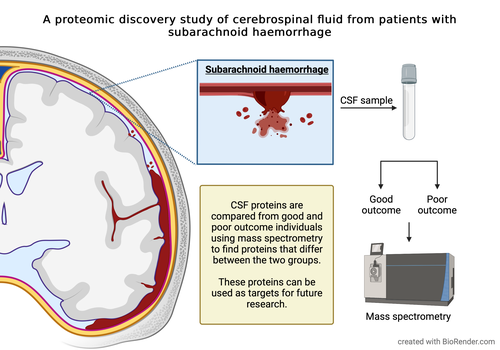
2021 Entry Clinical Fellowship
A proteomic discovery study of cerebrospinal fluid after subarachnoid haemorrhage
Subarachnoid haemorrhage is a type of stroke. It occurs when a weakness in a blood vessel (an aneurysm) bursts releasing blood over the surface of the brain. It is the most severe type of stroke: a third of patients die, a third are disabled, and even amongst the third that regain independence, most have significant problems with fatigue, anxiety and cognition that change their lives forever.
Very little is known about what mechanisms cause brain damage and disability after a subarachnoid haemorrhage.
My aim is to improve our understanding of the mechanisms underlying brain injury after a subarachnoid haemorrhage and why some individuals suffer more serious complications and disability than others. If we can better understand what underlies brain damage and disability, and what mechanisms are involved, ultimately, we can develop treatments to prevent the devastating consequences of this type of brain bleed.
To do this I will study the brain fluid (also called cerebrospinal fluid or CSF) from patients who have suffered a subarachnoid haemorrhage. I will look at how proteins in the brain fluid differ between patients with different amounts of brain damage following a subarachnoid haemorrhage. Proteins form the structure of all living things and are coded by our genes. There are many thousands of proteins in the human brain. Previous studies have chosen only a small number of proteins to look at without building up a full picture. This study will build a complete picture by looking at how all the thousands of proteins interact and change after subarachnoid haemorrhage.
If I find that there are protein differences which explain the amount of brain damage following subarachnoid haemorrhage, they would then be good targets to study in the future in my aim to improve outcomes and help to treat this devastating condition.

Currently a NIHR Clinical Lecturer in Neurosurgery, University of Southampton
Publications
The haptoglobin response after aneurysmal subarachnoid hmaoerrhage
International Journal of Molecular Sciences 2023, 24(23), 16922; doi:10.3390/ijms242316922
2023
Risk of subarachnoid haemorrhage reduces with blood pressure values below hypertensive thresholds
European Journal of Neurology 2023 Oct 25. doi: 10.1111/ene.16105.
2023
Aneurysm management in patients over 80 years old with good grade subarachnoid haemorrhage
British Neurovascular Group (BNVG). Br J Neurosurg. 2023 May 5:1-7. doi:10.1080/02688697.2023.2205939.
2023
Sphingosine-1-phosphate Signalling in Aneurysmal Subarachnoid Haemorrhage: Basic Science to Clinical Translation
Translational Stroke Research 2023 Feb 7. doi: 10.1007/s12975-023-01133-9
2023
Genetic variation in NFE2L2 is associated with outcome following aneurysmal subarachnoid haemorrhage
European Journal of Neurology 2023 Jan;30(1):116-124. Doi: 10.1111/ene.15571 Covered by editorial.
2023
Duration and characteristics of persistent headache following aneurysmal subarachnoid hemorrhage
Headache. Nov 25 2022; https://doi.org/10.1111/head.14418
25 November 2022
Evidence-based interconversion of the Glasgow Outcome and modified Rankin scales: pitfalls and best practices
Journal of Stroke & Cerebrovascular Diseases, Dec 2022;31(12):106845; https://doi.org/10.1016/j.jstrokecerebrovasdis.2022.106845
26 October 2022
Changes in outcome prediction during the first week after subarachnoid hemorrhage
doi:10.1227/neuopn.0000000000000021, doi:10.1227/neuopn.0000000000000021
2022
A Genome-Wide Association Study of Outcome After Aneurysmal Subarachnoid Haemorrhage: Discovery Analysis
Translational Stroke Research Oct 20 2022; https://doi.org/10.1007/s12975-022-01095-4
20 October 2022
Aspirin and Subarachnoid Haemorrhage in the UK Biobank
Translational Stroke Research 2022 Jul 9. doi: 10.1007/s12975-022-01060-1
2022
Genetic variation in NFE2L2 is associated with outcome following aneurysmal subarachnoid haemorrhage. Eur J Neurol
European Journal of Neurology, Sep 23 2022; https://doi.org/10.1111/ene.15571
23 September 2022
Association of Haptoglobin Phenotype With Neurological and Cognitive Outcomes in Patients With Subarachnoid Hemorrhage
Frontiers in Aging Neuroscience 2022. Doi: 10.3389/fnagi.2022.819628
2022
Long-term fatigue following aneurysmal subarachnoid haemorrhage and the impact on employment
European Journal of Neurology, Aug 30 2022; https://doi.org/10.1111/ene.15533
30 August 2022